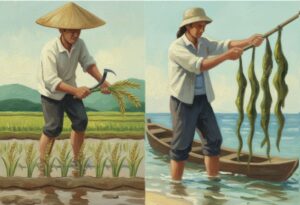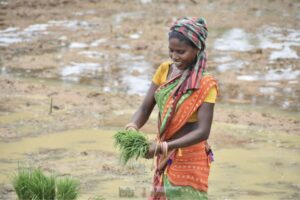
Brazil is the ninth-largest producer of rice worldwide and it is the biggest producer outside Asia. Brazil first reached rice self-sufficiency in 2003-04. Now, it imports and exports rice. In 2008, Brazil doubled its rice exports from the previous year to 400,000 tons—most of which went to Africa. Interestingly, Brazil exported only around 37,000 tons in 2004; so, it has increased its exports more than tenfold in just 4 years. But, in 2008, it imported around 615,000 tons.
Rice in Brazil is grown under two ecosystems: irrigated (75% of production) and upland (25% of production), and both have potential for expansion. Each system occupied around 50% of the total area of 2.9 million hectares in the 2010-11 cropping season. Since the early 1980s, there has been a steady reduction in upland rice areas and significant increases in irrigated rice area. Hence, although there was 50% less land (3 million hectares), rice production still rose by 50%—an enormous achievement in eco-efficiency. Irrigated rice in Brazil represents indica subspecies, while upland cultivars are japonica.
The most important share of production comes from the sub-tropical temperate environment of the south, under the irrigated system, accounting for 70% of Brazil’s rice production.
Rice research in Brazil
Three main public institutions are involved in rice variety development in Brazil: the Rice Institute of the State of Rio Grande do Sul (IRGA), the Santa Catarina State Agricultural Research and Rural Extension Agency (Epagri), and the Brazilian Agricultural Research Corporation (Embrapa) under the Ministry of Agriculture, Livestock, and Food Supply (see The perfect marriage). IRGA was created in 1948, Embrapa in 1973, and Epagri in 1975.
Rice breeding in Brazil
Several rice varieties have been released in Brazil. A total of 49 varieties were recommended for the 2010-11 cropping season from the 3 main public institutions. Of those, 7 were developed by IRGA, 7 by Epagri, 3 by IRGA and Embrapa, 2 by Epagri and Embrapa, and 30 by Embrapa (including 1 with the state institutions of Goiás and 6 with Minas Gerais). In total, 38 rice varieties have been developed for irrigated regions and 11 for the upland area. CIRAD germplasm contributed in 10 cultivars recommended for the upland system.
Hybrids delivered by RiceTec have been grown since 2003, and, in 2009-10, they occupied 34,000 hectares. Embrapa and the Centre de Coopération Internationale en Recherche Agronomique pour le Développement (CIRAD), a French research center working with developing countries to tackle international agricultural and development issues, released their first hybrid rice cultivar in 2010—a product of a joint research program.
In recent years, problems from contamination by red rice, the most important weed in irrigated areas, have pushed growers to use herbicide-resistant cultivars. Cultivar PUITÁ INTA CL, released in Brazil by BASF in 2008, occupied around 35% of irrigated rice fields in the 2009-10 cropping season. It was developed using IRGA 417 that was obtained from the cross of Newrex, IR19743-25-2-2, and BR-IRGA 409.
CIAT
The International Center for Tropical Agriculture (CIAT), established in Colombia, is the most important institution that introduces modern rice germplasm in Brazil, in both irrigated and upland systems. Out of 49 varieties released by the main public institutions in the market, 37 incorporate CIAT-originated germplasm. The most notable is BR-IRGA 409 that was released in 1978. It brought the indica’s short stature, abundant tillering, long grains, and higher yields. BR-IRGA 409 has persisted in the market because of its remarkable grain quality.
FLAR
The Latin American Fund for Irrigated Rice (FLAR) is a public-private regional partnership founded to consolidate rice research and development in Latin America (see FLAR syngery in The promise of Latin America). As noted by its director, Mr. Gonzalo Zorrilla, FLAR has a grass-roots network of local institutions capable of focusing on applied research that can act as a bridge to bring new technologies to farmers (see The new global rice agenda: A Latin American perspective).
FLAR supports breeding efforts for the tropical and temperate zones of Latin America. However, it has taken on a particularly important role in undertaking agronomic research and technology transfer to boost yields.
In alliance with IRGA, its partner in Brazil, FLAR helped transform crop management in Rio Grande do Sul, the southernmost state of Brazil, where average yields of a million hectares of rice have increased by 2 tons per hectare since early 2000 (see Rice revolutions in Latin America).
IRRI
Through the Global Rice Science Partnership, the International Rice Research Institute (IRRI), together with its partners in the region, plans to play an increasing role in developing and delivering rice technologies to help advance the rice sector in Latin America, including Brazil (see Blueprint for a greener revolution.)
_________________________________
Acknowledgments go to Embrapa, CIAT, FLAR, Epagri, IRGA, and CIRAD.
_________________________________
Ms. Clayton is the former head of IRRI’s Public Relations team.
Dr. Neves is a researcher for rice in Embrapa.









